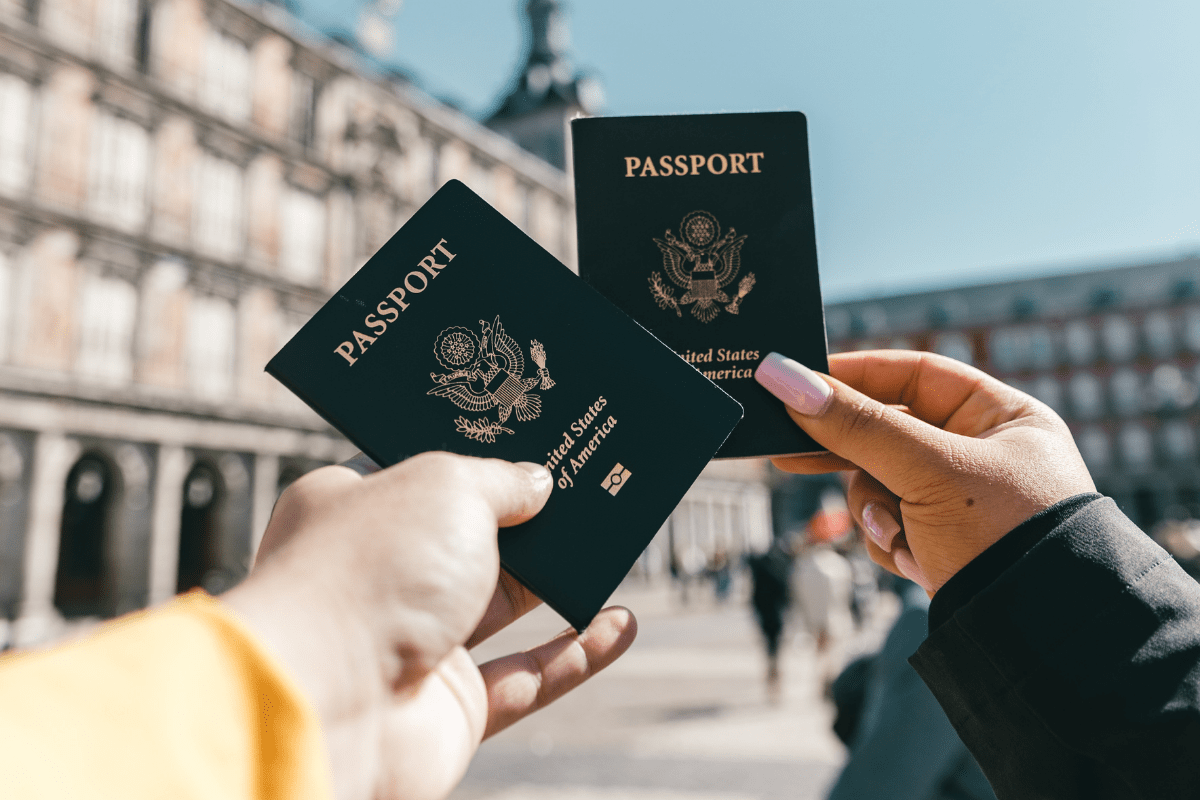Planning your first international trip feels like preparing for a space mission, except NASA doesn't have to worry about forgetting their passport. The good news is that millions of people figure this out every year, and with the right preparation, you'll be confidently navigating foreign airports and ordering mysterious foods like a seasoned traveler. This guide covers everything you need to know, from the boring-but-essential paperwork to the fun stuff like not looking like a tourist (spoiler: you probably will anyway, and that's okay).
Get your paperwork sorted first
Before you start dreaming about croissants in Paris or temples in Thailand, you need to tackle the least exciting part of travel planning: documents. Think of this as building the foundation of your house. Skip it, and everything else collapses in a spectacular mess at the airport.
Your passport is your golden ticket
If you don't have a passport, stop reading this and apply for one right now. Seriously, I'll wait. Passport processing takes 6-11 weeks for routine service, and up to 18 weeks during busy periods, which means "I'll get it next month" turns into "guess I'm not going to Europe after all."
Your passport needs to be valid for at least six months beyond your planned return date. Yes, even if you're only going for a week. Many countries will literally turn you away at the border if your passport expires too soon. You also need 2-4 blank pages for entry and exit stamps, because apparently customs officials are very particular about having clean space for their artwork.
Essential passport checklist:
- Valid 6+ months past return
- At least 2 blank pages
- No damage or wear
- Apply 6+ months early
Pro tip that'll save you money: those passport photos at CVS cost $15-20, but you can take perfectly acceptable photos at home using smartphone apps for under $5. The government just wants a clear photo of your face, not a professional headshot.
New travel authorizations are changing everything
Here's where things get interesting (and slightly annoying). Starting in 2025, several countries have added new requirements that even seasoned travelers are scrambling to understand.
If you're heading to the UK, you now need an Electronic Travel Authorization (ETA) that costs about $13 and is valid for two years. It's basically like the ESTA system we make other countries' citizens use to visit us. Turnabout is fair play, I suppose.
Europe is following suit with something called ETIAS, expected to launch in May 2025. This will be required for 30 European countries and works similarly to the UK system. The good news is that once you have it, you can use it for multiple trips over three years.
2025 authorization requirements:
- UK ETA: $13, valid 2 years
- Europe ETIAS: Expected May 2025
- Apply 1+ weeks before travel
- Multiple entries allowed
Visa requirements vary wildly by destination
This is where research becomes your best friend. Some countries welcome Americans with open arms and a 90-day tourist stamp, while others require you to jump through bureaucratic hoops that would make a circus performer dizzy.
The easy destinations include most of Europe (90 days in a 180-day period), Japan, South Korea, and Australia (with their version of an ETA). The more complicated ones (China, Russia, India, Brazil for tourism) require advance visa applications that can take weeks or months.
Check the State Department's country information pages for your destination. These get updated regularly because countries love changing their rules just to keep us on our toes.
Protect yourself financially
Nothing ruins a dream vacation quite like discovering your credit card doesn't work, your phone bill is $500, or you're facing a $50,000 medical evacuation bill. Let's prevent those nightmares.
Travel insurance isn't just for nervous parents
I used to think travel insurance was for overly cautious people until I met someone who broke their leg skiing in Switzerland and faced a $75,000 bill. Now I'm a convert, and you should be too.
Comprehensive travel insurance typically costs 5-10% of your total trip cost. For a $3,000 trip, that's $150-300 for peace of mind. Medical-only policies average around $96, which is less than most people spend on airport food.
Here's what many first-time travelers don't realize: your regular health insurance probably doesn't work internationally. Medicare and Medicaid definitely don't cover you abroad, and even private insurance often has limited international coverage.
Essential coverage types:
- Medical: $100,000+ minimum
- Emergency evacuation: $500,000+
- Trip cancellation protection
- Lost luggage coverage
Buy your policy within 7-21 days of booking your trip to get maximum coverage, including protection for pre-existing conditions. Companies like Squaremouth let you compare policies easily.
Set up your money situation properly
Banks have gotten much better about international transactions, but you still need to plan ahead. Call your bank and credit card companies to tell them you'll be traveling. Nothing's more embarrassing than having your card declined while trying to pay for dinner in Rome.
Get a credit card with no foreign transaction fees if you don't already have one. These fees add up quickly. Three percent on every purchase means that $100 dinner just cost you $103 for no good reason.
Financial preparation checklist:
- Notify banks of travel dates
- Get no-fee international cards
- Order local currency in advance
- Download banking apps
Order some local currency from your bank 2-3 weeks before you travel. You don't need much. $100-200 is plenty for tips, taxis, and situations where cards don't work. Don't exchange money at the airport unless it's an emergency; the rates are terrible.
Stay connected without going broke
Your phone is probably your lifeline while traveling, but international roaming charges can turn your vacation into an expensive nightmare. Some carriers charge up to $20 per day for international plans, which adds up fast.
Smart connectivity options save serious money
The game-changer is eSIM technology. Apps like Airalo offer data plans for about $5-15 per week, compared to $20 per day from your regular carrier. I used Airalo in Europe last year and paid $5 for a week of data that would have cost $140 with my regular carrier.
Before you travel, make sure your phone is unlocked. If you're still paying off your phone, it might be locked to your carrier. Call them to unlock it, which is usually free once you've met their requirements.
Connectivity options ranked by value:
- eSIM services: $5-15 per week
- Local SIM cards: $10-30 total
- Carrier international plans: $10-20 daily
- Wi-Fi only: Free but limiting
Download offline maps before you leave home. Google Maps lets you download entire cities, which is incredibly helpful when you're lost in a place where you don't speak the language and your data isn't working.
Essential apps for international travel
Google Translate is magic. You can point your camera at signs and menus to get instant translations, and it works offline once you download the language pack. It's not perfect, but it's good enough to help you figure out whether you're ordering chicken or liver.
Download apps for public transportation in your destination city. Citymapper works in most major cities worldwide and will save you from staring confused at subway maps like a stereotypical tourist.
Keep yourself healthy and safe
International travel exposes you to new germs, different altitudes, unfamiliar foods, and the stress of navigation. A little preparation goes a long way toward keeping your trip fun instead of miserable.
Medical preparation is boring but important
Check the CDC's travel recommendations for your destination 4-6 weeks before you travel. Some countries require specific vaccinations, and others just recommend them. Yellow fever vaccination, for example, is required for entry to certain countries if you're coming from areas where it's present.
Pack twice as much medication as you think you'll need, and keep it in original containers with prescription labels. Bring copies of prescriptions with generic drug names. Different countries use different brand names for the same medications.
Health prep essentials:
- Check vaccination requirements early
- Pack extra medications
- Bring prescription copies
- Consider altitude if applicable
If you're going somewhere high altitude like Cusco, Peru, research altitude sickness prevention. Some people are fine, others feel terrible for days. There are medications that can help, but you need to start them before you arrive.
Safety preparation without paranoia
Register with the State Department's STEP program so the embassy knows you're in the country and can contact you if something happens. It's free and takes five minutes.
Research common scams in your destination, not to make you paranoid, but to recognize them when they happen. The "friendship bracelet" scam in Paris, the "gold ring" trick in various European cities, and taxi overcharging happen to tourists everywhere.
Share your detailed itinerary with someone at home and set up regular check-ins. It doesn't have to be daily, but someone should know roughly where you are and when to worry if they don't hear from you.
Navigate airports like you know what you're doing
International airports can be overwhelming. They're basically small cities with terrible signage and overpriced food. But the process is more straightforward than it seems once you break it down.
The international flight process step by step
Arrive three hours early for international flights, even if that seems excessive. International terminals are often farther from parking, check-in lines can be longer, and you need extra time for immigration procedures.
Check in online 24-48 hours before your flight if possible. This guarantees your seat assignment and often lets you skip to bag drop lines instead of waiting in full check-in lines.
Airport navigation steps:
- Online check-in 24-48 hours early
- Arrive 3 hours before departure
- Check bags if needed
- Security screening
- Immigration/passport control
- Find your gate early
The security process varies by country, but generally involves removing electronics larger than a phone, taking off shoes, and following the liquids rule (3-1-1 in the US). Some countries are more relaxed, others more strict.
After security, you'll go through passport control where an officer will check your documents and stamp your passport. They might ask about your trip purpose, how long you're staying, and where you're going. Keep it simple: "Tourism, one week, staying in hotels."
Surviving long international flights
Long flights are endurance tests disguised as transportation. Choose an aisle seat if you think you'll need bathroom breaks or want to walk around, which you should do every few hours to prevent blood clots.
Download entertainment before you travel. Airplane Wi-Fi exists but it's expensive and unreliable. Load up your phone or tablet with movies, shows, podcasts, or audiobooks.
Stay hydrated but don't overdo it. You don't want to spend the entire flight climbing over your seatmate. Limit alcohol, which makes jet lag worse and dehydrates you more at altitude.
Navigate cultural differences gracefully
Every country has its own quirks, and part of the fun of travel is figuring them out. You don't need to become a cultural expert overnight, but a little awareness goes a long way.
Money customs that matter
Tipping varies dramatically around the world in ways that can seem completely random. In Japan, tipping is actually considered rude. The price you're quoted includes service. In most of Europe, 10% is fine if there's no service charge already included. In Southeast Asia, small tips are appreciated but not expected.
Global tipping quick guide:
- Japan: Don't tip (seriously)
- Europe: 10% without service charge
- Southeast Asia: Small tips welcomed
- Research your specific destination
Payment preferences also vary wildly. Scandinavian countries are nearly cashless. I once bought a $2 coffee in Stockholm with a credit card and nobody blinked. Germany, on the other hand, is still very cash-focused, and many restaurants don't accept cards.
Communication that works everywhere
Learn to say "hello," "please," "thank you," and "excuse me" in the local language. You don't need to be fluent, but making an effort is universally appreciated. Most people will switch to English if they can, but starting in their language shows respect.
When you don't speak the language, pointing works surprisingly well. Restaurant menus, maps, and translation apps can get you far. Don't be embarrassed. Most locals are patient with obviously lost tourists who are trying to be polite.
Observe how locals behave and try to match their energy level. Some cultures are more formal, others more casual. When in doubt, err on the side of being more polite and reserved until you get a feel for the place.
Handle daily logistics like a pro
The day-to-day reality of international travel involves figuring out transportation, food, and basic navigation in places where everything works slightly differently than home.
Getting around efficiently and cheaply
Public transportation is usually your best bet for getting around cities. It's cheaper than taxis, often faster than driving, and gives you a more authentic local experience. Download the transit app for your destination city before you arrive.
Buy day passes or multi-day passes for public transit instead of individual tickets. The math almost always works out in your favor, and you don't have to figure out the ticket machine every time you want to go somewhere.
Transportation money-savers:
- Day passes vs individual tickets
- Book airport transfers in advance
- Walk during daylight hours
- Use ride-sharing apps cautiously
Walking is underrated for sightseeing. Most European city centers are compact and walkable, and you'll see things you'd miss from a bus or subway. Just plan your walking routes during daylight hours for safety and better photo opportunities.
Eating abroad without fear
Start with familiar international chains while you adjust to the local food scene. I'm not saying eat McDonald's in Paris, but a familiar coffee chain can be a comfortable base while you work up courage for more adventurous dining.
Lunch menus at nice restaurants are often significantly cheaper than dinner menus at the same places. You'll get the same quality food and service for less money, plus you'll have energy for evening activities instead of falling into a food coma.
Local markets are goldmines for authentic, affordable food. Even if you can't identify everything, vendors are usually happy to point you toward popular items. Look for stalls with lines of locals. That's always a good sign.
Prepare for things to go wrong
Travel problems aren't a matter of if, they're a matter of when. The difference between a minor inconvenience and a major disaster is usually preparation and knowing what to do.
Lost passport survival guide
If you lose your passport abroad, don't panic. It happens more often than you'd think. First, file a police report immediately. Many countries require this before the embassy will help you, and your travel insurance might need it too.
Contact the nearest US Embassy or Consulate as soon as possible. They can issue emergency passports, usually within 24-48 hours. Bring backup passport photos, copies of your ID, and any documentation you have about your travel plans.
Lost passport action plan:
- File police report immediately
- Contact nearest US Embassy
- Bring backup photos and IDs
- Emergency passport: 24-48 hours
This is why you should always keep copies of important documents in multiple places: your phone, email, and physical copies in different bags. Cloud storage is your friend here.
Financial emergency backup plans
Bring cards from different banks in case one gets frozen or stops working. I learned this lesson the hard way in Thailand when my primary bank decided my spending pattern looked suspicious and froze my account while I was 12 time zones away from customer service.
Save your banks' international customer service numbers in your phone before you travel. The number on the back of your card might not work from abroad, and you don't want to be searching for contact information when you're already stressed.
Keep some emergency cash in a separate, secure location from your primary wallet. If your cards stop working or you lose your wallet, having backup cash can get you through until you sort everything out.
Make the most of your adventure
Your first international trip is a milestone, and you want it to be memorable for the right reasons. The key is balancing planning with flexibility, and being open to experiences you can't have at home.
Smart planning that leaves room for magic
Book your flights and accommodations in advance, especially during peak season, but don't plan every hour of every day. Over-scheduling is a common first-timer mistake that leads to exhaustion and missed opportunities.
Plan one or two must-see activities per day maximum, and leave time for wandering, unexpected discoveries, and rest. You'll walk more than you expect, eat different foods that might affect your energy levels, and want time to process new experiences.
Balanced planning approach:
- Book major items in advance
- Plan 1-2 activities per day max
- Leave time for spontaneity
- Quality over quantity always
The best travel memories often come from unplanned moments: conversations with strangers, stumbling across festivals, or discovering hole-in-the-wall restaurants that aren't in any guidebook.
Building confidence for future adventures
Your first international trip is practice for all the adventures that follow. Focus on mastering the basics rather than trying to do everything perfectly. Each trip will build your confidence and reveal new interests and destinations.
Success on your first international trip means navigating airports without major stress, communicating your basic needs, managing money effectively, staying safe and healthy, and returning home with positive memories and the desire to travel more.
Remember that travel is a skill that improves with practice. Your first trip might feel overwhelming at times, but that's normal. Every experienced traveler was once standing confused in their first foreign airport, wondering if they were doing anything right.
The world is full of incredible places and experiences waiting for you. Take that first step, book that ticket, and trust that you're more capable than you think. Your future well-traveled self is going to thank you for having the courage to start this adventure.





